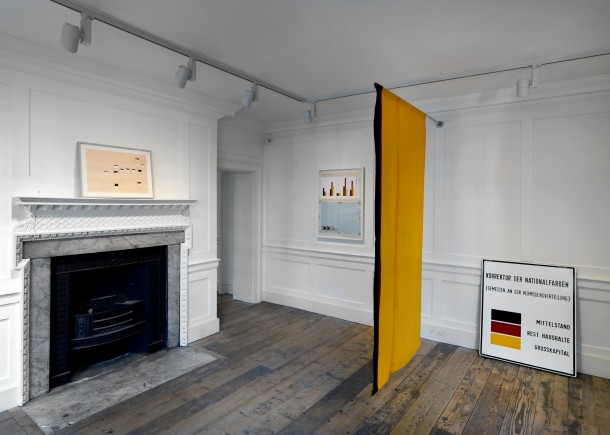KP BREHMER: REAL CAPITAL PRODUCTION
| December 5, 2014
![KP Brehmer, Works from ‘Ideale Landschaft’ [Ideal Landscape] series, 1968 Block Collection on loan to Neues Museum, Nuremberg PHOTO: Marcus J. Leith Courtesy of Estate of KP Brehmer, Berlin](http://leapleapleap.com/wp-content/uploads/2014/12/1-610x422.jpg)
Landscape] series, 1968
Block Collection on loan to Neues Museum,
Nuremberg
PHOTO: Marcus J. Leith
Courtesy of Estate of KP Brehmer, Berlin
HOW DO YOU occupy something as abstract as capitalism? This was one of the main questions posed by the Occupy movement in its quest towards an alternative system; one that was more sustainable, democratic, and just. A system run by corporations directs our understanding and representation of the world. To fully understand a system you must study it, visualize it and dismantle it. But how does one visualize capital?
The answer is spelled out very eloquently by the German artist KP Brehmer (1938–1997), just around the corner from the Bank of England, the former stage of the Occupy movement. Raven Row gallery presents an exhibition of art as commodity; with evidence in the form of drawings, prints, paintings, films, objects and publications, some of them never before exhibited. Brehmer uses abstract data from charts and maps, slightly altering the results and then turning them into paintings and prints—explaining the modus operandi of capitalism.
![Sichtweiten über der Po-Ebene (Mailand) [Views over the Po Valley (Milan)], 1978 Federal Republic of Germany – Collection of Contemporary Art, Courtesy of Kunsthalle Hamburg](http://leapleapleap.com/wp-content/uploads/2014/12/8-610x449.jpg)
Federal Republic of Germany – Collection of Contemporary Art, Courtesy of Kunsthalle Hamburg
Brehmer lived most of his life in West Berlin, a city divided by capitalism and socialism, where he experienced the effects of the Cold War on a daily basis. In Korrektur der Nationalfarben (1972), the different colours of the German flag represent the amount of wealth among the different social classes in German society. As one can expect from Brehmer, the proportions of the flag are distorted: the symbol of national power and unity no longer exists, now symbolizing inequality and antagonism. In Realkapital—Produktion from 1974, three painted graphic charts show the state of corporate profits.
A message’s effect is determined by how well it is delivered. The relevance and importance of Brehmer’s beautiful and pioneering display of the capitalism of the every day has only now been recognized. Successful action against capitalism must involve challenging, replacing and understanding that same system. Brehmer stretches the limits and experience of reality, and therefore does not need to occupy it.
“KP Brehmer,” Raven Row gallery, London
September 24- November 30, 2014

KP Brehmer. Real Capital Production, Raven Row,
2014
PHOTO: Marcus J. Leith
Courtesy of Estate of KP Brehmer, Berlin

